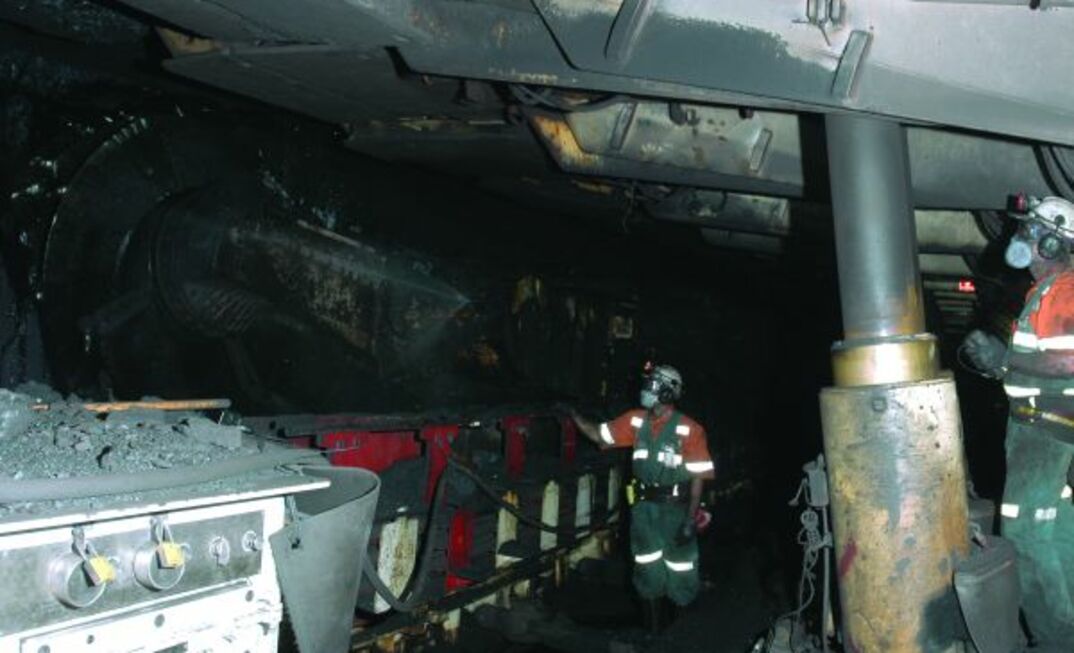Published in March 2010 Australian Longwall Magazine
Presenting at the 8th Annual Longwalls Conference in October, Broadmeadow longwall superintendent Brett Moule delved into the mine’s adoption of longwall automation technology to deliver the best results.
A punch longwall mine in Queensland’s Bowen Basin, Broadmeadow targets the 6.8-8.2m thick Goonyella middle seam with extraction typically between 3.8m and 4.8m.
With a problematic coal roof at play, the mine decided to break convention and reference its automated shearer equipment to the floor rather than the roof.
On adjusting the shearer automation, Moule said there was concern on where the shearer would end up, but a decision was made to proceed.
The shearer operator worked the ranging arm in a manual mode to cut the floor, while the shearer automatically cut the top two-thirds of the targeted seam in a Uni Di cutting pattern to the desired, programmed extraction height.
Moule said despite the progress with automation technology, for now it could not compete with human ears and eyes in finding the stone floor.
A crew of three operators cut a 320m-wide face from maingate to tailgate and back in about 45 minutes, delivering roughly 1600 tonnes in each shear.
The shearer operator only needs to go on the tailgate side of the shearer to cut the floor for about 20m so the 16m-long shearer can then predict the floor position for the entire face.
While the automation speeds up the cutting considerably, Broadmeadow will also use a manual target option to do corrections in a single shear.
Moule said the LASC-automated equipment would do flight paths but needed to know exactly where the seam was heading, and the best way to tell was to stand and listen.
“We can tell it to do anything we like but where it ends up over five or six or eight shears, who knows?” he said.
“If you need to stand at the maingate and correct every shear, you might as well move with the shearer, because we can do the correction right there and then with the remote.”
CSIRO’s computer, part of the ACARP Landmark initiative technology, would put target lines for two shears ahead, but once crews got a pan profile, they did a target line (string line) through Bucyrus’s VShield software to straighten up the shields when required.
“Using the target lines in VShields means we do not have to slow down the shearer while the face is being straightened, whereas a manual stringline straightening cut from tailgate to maingate can take between 55 to 80 minutes as the shearer speed is reduced to help the operator manually advance the 38-tonne shields,” Moule said.
BMA estimates the lost opportunity from this non-automated work costs 1300t per shift, 15,600t per week and 71,760t per month at one straightening cut per shift.
“Potential lost opportunities really answers the question, what are the benefits of going down the longwall automation path?” Moule said.
Operators needed to communicate with OEMs on what they required from automation and the mine needed to own and refine the process.
“Communication networks need to be looked after and a fair bit of tweaking goes on; however, the PM4 system is 25-year-old technology but very stable. We can do with a little bit more room in the memory for some advanced activities we want to do in the future.”
For future development, Broadmeadow aims to use available 3D imagery for real-time monitoring of face position, horizon and alignment.
While Moule views the alignment aspects as covered, he said enhanced horizon control, specifically at the maingate end, was the next challenge.
“Because our seam is so thick and our floor is a little soft, our development guys actually leave 700-800mm of coal on the floor, so we ramp down from the maingate onto the face over about 20 shields,” he said.
The size of the shearer was problematic as cameras could not adequately look at the bottom of a 2.5m drum. While infrared did make out bands on the face, it was not well defined because of the dust.
As another step in refining its use of automated mining, Broadmeadow aims to get the shearer to communicate to the AFC pans and to keep it sitting right on the stone floor.
To monitor creep, Broadmeadow has successfully trialled lasers, which also bounce off the roof and rib, and is working on a mimic page for the automation software to trend the creep and remove human error.
“Basically we can integrate the mimic page with the CSIRO stuff in with VShields – potentially we can make the face decide when it needs a flight path itself,” Moule said.
At this stage he did not want to launch fully into automated creep control, preferring to trend on screen and leave it up to the operators until more progress was made with developing the technology.
Broadmeadow is currently mining longwall panel 5 with depth of cover of 250m, but future mining of panels to the east will be at depths to 400m.
Moule said the mine had improved operationally with its automated gear, mining 2.6 million tonnes in 2005, 3.5Mt in 2006, 4.1Mt in 2007 and 4.4Mt in 2008.
The Broadmeadow longwall uses the EL3000 shearer, a 1342 PF6 AFC (3 x 1200kW) with a 48mm chain, a 1542 PF6 BSL (500kW) with a 42mm power chain, 1152t roof supports with PM4 control and four 375 litre per minute Inoxihp pumps.
























